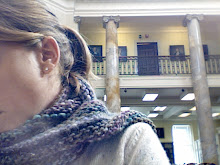place and space
I’ve been trying to figure out why I’ve had such an auspicious start with my students this summer (which is not to say that things will continue this way, especially because we're onto Benito Cereno this week). As far as I know, just one thing has changed this year. I’m teaching in a room with a large seminar table (i.e. Harkness table) instead of moveable chairs. So 16 of us (14 students, 1 TA, and me) face each other directly, and no one can risk falling asleep, zoning out, staring at the clock (there isn’t one). There’s simply no place to hide. But beyond making classroom management cinch, students naturally direct their response to one another. Instead of the teacher at front and center, any student can be – literally and metaphorically – at the head of the table. My seat is no different than theirs, suggesting, I suppose, that my ideas are of equal relevance. But I should be clear: I don’t absolutely buy into exclusively student-centered pedagogy. After all, my instincts tell me the instructor should not shy away from sharing her accumulation of knowledge when it’s needed to elucidate a particularly tricky concept or inscrutable stanza.
Most of my students come from schools with moveable desks, and the change to a single table would seem to force a student to shift his conception of his role as a student. One behaves differently at a table with others than she does at an island desk alone (i.e. she could be carving KISS in zig-zagging letters into its laminate top without the teacher noticing). Coupled with this kind of action switching is the historic heft of the table, generating, it seems to me, some sense that sitting around it may inspire unusually keen insights.
I can’t imagine a way to transport the seminar table into the public school classroom of 35 students. But I want to try to think about why it feels so different discussing around a table compared to at desks pushed together in a circle.
Photos to come later, I promise.
On the Harkness method: http://www.exeter.edu/admissions/147_465.aspx
Sunday, July 1, 2007
Subscribe to:
Post Comments (Atom)

4 comments:
why don't you just ask to hold your american studies class next year up in gaskin or the room on the other end of the 5th floor?
most of my classes in college were at tables. it was nice - but you need smaller classes for it to work well.
I absolutely agree that there's a huge difference between a large table and desks. Even when you put the desks in a circle, it still "feels" different than when you all sit at a big seminar table. I've noticed it for classes I've taught and classes I've taken. Classroom atmosphere plays a huge role in day-to-day education. Thus the irony of Greenlaw's hideous exterior and interior.
Two things about the Harkness table:
1) It is keenly designed so that every single person at the table can pick up on all the nuances, such as gestures, facial expressions, slouches, nods, direct eye contact, etc. Bodies play an active part in the discussion. You can't do this as well with desks pushed together or at any other kind of table. Trust me, I've tried.
2) The Harkness table links kids across a shared space. The table functions as much as the text does to unite the group. There is a sense of commonality and shared purpose that just isn't there with a huge gap of space in the middle.
Post a Comment